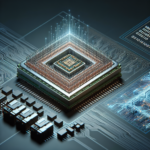The Role of CPUs in High-Resolution 3D Printing

The Role of CPUs in High-Resolution 3D Printing
High-resolution 3D printing has revolutionized various industries, from healthcare to aerospace, by enabling the creation of intricate and precise objects. While much of the focus in 3D printing technology is often on the printers themselves, the role of Central Processing Units (CPUs) is equally critical. CPUs are the brains behind the operation, managing complex calculations, data processing, and control tasks that are essential for high-resolution 3D printing. This article delves into the multifaceted role of CPUs in high-resolution 3D printing, exploring their importance, functionality, and impact on the quality and efficiency of the printing process.
Understanding High-Resolution 3D Printing
What is High-Resolution 3D Printing?
High-resolution 3D printing refers to the process of creating three-dimensional objects with extremely fine detail and precision. This is achieved by using advanced 3D printers that can produce layers as thin as a few microns. High-resolution 3D printing is crucial for applications that require intricate designs, such as medical implants, dental prosthetics, and detailed prototypes in engineering and design.
Key Components of High-Resolution 3D Printing
Several components work in tandem to achieve high-resolution 3D printing:
- 3D Printer: The hardware that physically creates the object.
- Software: Programs that design and slice the 3D model into layers.
- Materials: Filaments, resins, or powders used to build the object.
- CPU: The central processing unit that manages data and controls the printing process.
The Role of CPUs in 3D Printing
Data Processing and Management
One of the primary roles of the CPU in high-resolution 3D printing is data processing and management. High-resolution 3D models are often complex and require significant computational power to process. The CPU handles tasks such as:
- Model Slicing: Dividing the 3D model into thin layers that the printer can build sequentially.
- Path Planning: Determining the optimal path for the printer head to follow, ensuring efficiency and accuracy.
- Error Checking: Identifying and correcting errors in the model or the printing process.
Control and Coordination
The CPU also plays a crucial role in controlling and coordinating the various components of the 3D printer. This includes:
- Temperature Control: Managing the temperature of the print bed and extruder to ensure proper material adhesion and layer bonding.
- Movement Control: Coordinating the movement of the printer head and print bed to achieve precise layer placement.
- Material Flow: Regulating the flow of material to ensure consistent extrusion and prevent clogs or gaps.
Real-Time Monitoring and Adjustments
High-resolution 3D printing requires real-time monitoring and adjustments to maintain quality and accuracy. The CPU continuously monitors various parameters and makes necessary adjustments, such as:
- Layer Height: Ensuring each layer is printed at the correct height to maintain resolution.
- Print Speed: Adjusting the speed of the printer head to balance quality and efficiency.
- Environmental Conditions: Monitoring and adjusting for changes in temperature, humidity, and other environmental factors.
Impact of CPU Performance on 3D Printing
Speed and Efficiency
The performance of the CPU directly impacts the speed and efficiency of the 3D printing process. A powerful CPU can process data and execute commands more quickly, reducing the time required to print high-resolution objects. This is particularly important for industrial applications where time is a critical factor.
Quality and Precision
High-resolution 3D printing demands exceptional quality and precision. A high-performance CPU ensures that the printer can execute complex tasks with minimal errors, resulting in objects with fine details and smooth surfaces. This is essential for applications such as medical implants, where precision is paramount.
Scalability
As 3D printing technology advances, the complexity and size of printable objects continue to grow. A robust CPU can handle larger and more complex models, enabling the creation of intricate designs that were previously impossible. This scalability is crucial for industries that require custom, high-resolution parts.
Choosing the Right CPU for High-Resolution 3D Printing
Factors to Consider
When selecting a CPU for high-resolution 3D printing, several factors should be considered:
- Processing Power: A powerful CPU with multiple cores and high clock speeds can handle complex calculations and data processing more efficiently.
- Compatibility: Ensure the CPU is compatible with the 3D printer and software being used.
- Thermal Management: High-performance CPUs generate heat, so effective cooling solutions are essential to maintain stability and performance.
- Budget: While high-end CPUs offer superior performance, they can be expensive. Balance performance needs with budget constraints.
Recommended CPUs
Several CPUs are well-suited for high-resolution 3D printing:
- Intel Core i9: Known for its high clock speeds and multiple cores, the Intel Core i9 is ideal for handling complex 3D printing tasks.
- AMD Ryzen 9: Offering excellent multi-threading capabilities, the AMD Ryzen 9 is a strong contender for high-resolution 3D printing.
- Intel Xeon: Designed for professional and industrial applications, Intel Xeon CPUs provide robust performance and reliability.
Future Trends in CPU Technology for 3D Printing
Advancements in Processing Power
As CPU technology continues to advance, we can expect even greater processing power and efficiency. This will enable more complex and detailed 3D models to be printed with higher resolution and speed. Future CPUs may also incorporate specialized features designed specifically for 3D printing applications.
Integration with AI and Machine Learning
The integration of artificial intelligence (AI) and machine learning with CPU technology holds significant potential for 3D printing. AI algorithms can optimize print paths, predict and correct errors, and enhance overall print quality. CPUs with built-in AI capabilities will further streamline and improve the 3D printing process.
Energy Efficiency
Energy efficiency is becoming increasingly important in CPU design. Future CPUs will likely focus on reducing power consumption while maintaining high performance. This will not only lower operational costs but also contribute to more sustainable 3D printing practices.
FAQ
What is the role of the CPU in 3D printing?
The CPU is responsible for data processing, control, and coordination of the 3D printing process. It handles tasks such as model slicing, path planning, error checking, temperature control, movement control, and real-time monitoring and adjustments.
How does CPU performance affect 3D printing quality?
A high-performance CPU ensures that complex calculations and data processing are executed quickly and accurately, resulting in high-quality, precise prints. It also enables real-time monitoring and adjustments to maintain print quality.
What factors should I consider when choosing a CPU for high-resolution 3D printing?
Consider factors such as processing power, compatibility with your 3D printer and software, thermal management, and budget. A powerful CPU with multiple cores and high clock speeds is ideal for handling complex 3D printing tasks.
Are there specific CPUs recommended for high-resolution 3D printing?
Yes, some recommended CPUs for high-resolution 3D printing include the Intel Core i9, AMD Ryzen 9, and Intel Xeon. These CPUs offer excellent processing power and multi-threading capabilities, making them well-suited for complex 3D printing tasks.
What future trends can we expect in CPU technology for 3D printing?
Future trends in CPU technology for 3D printing include advancements in processing power, integration with AI and machine learning, and increased energy efficiency. These developments will enable more complex and detailed prints, optimize the printing process, and reduce power consumption.
Conclusion
The role of CPUs in high-resolution 3D printing is indispensable. From data processing and management to control and coordination, CPUs are the driving force behind the precision and efficiency of the printing process. As CPU technology continues to advance, we can expect even greater capabilities, enabling more complex and detailed prints with higher resolution and speed. By understanding the critical role of CPUs and selecting the right one for your needs, you can significantly enhance the quality and efficiency of your high-resolution 3D printing projects.




